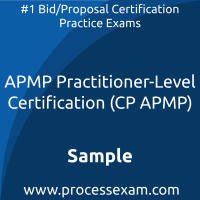 You have to pass the CP APMP exam to receive the certification from APMP. To increase the effectiveness of your study and make you familiar with the actual exam pattern, we have prepared this APMP Practitioner sample questions. Our Sample APMP Practitioner-Level Certification Practice Exam will give you more insight about both the type and the difficulty level of the questions on the APMP Practitioner exam.
You have to pass the CP APMP exam to receive the certification from APMP. To increase the effectiveness of your study and make you familiar with the actual exam pattern, we have prepared this APMP Practitioner sample questions. Our Sample APMP Practitioner-Level Certification Practice Exam will give you more insight about both the type and the difficulty level of the questions on the APMP Practitioner exam.
However, we are strongly recommending practice with our Premium APMP Practitioner-Level Certification (CP APMP) Practice Exam to achieve the best score in your actual APMP CP APMP Exam. The premium practice exam questions are more comprehensive, exam oriented, scenario-based and exact match of APMP Practitioner-Level Certification exam questions.
APMP Practitioner Sample Questions:
01. Which interpersonal skills are important for building trust with prospective customers?
(Select all that apply)
a) Active listening
b) Empathy
c) Assertiveness
d) Domination of discussions
02. What are the key components of a work breakdown structure (WBS)?
(Select all that apply)
a) List of tasks and activities
b) Team assignments
c) Customer budget details
d) Timeline for each task
03. Assertion: "Empathy is a critical skill for proposal managers when interacting with customers."
Reason: "It helps proposal managers understand and respond to customer emotions and needs effectively."
a) Both Assertion and Reason are true, and the Reason is the correct explanation of the Assertion.
b) Both Assertion and Reason are true, but the Reason is not the correct explanation of the Assertion.
c) The Assertion is true, but the Reason is false.
d) Both Assertion and Reason are false.
04. Match the following persuasive writing principles with their descriptions:
Principle
A. Clarity
B. Conciseness
C. Customer Focus
D. Structured Format
Description
1. Using simple and direct language
2. Avoiding unnecessary details
3. Highlighting benefits for the customer
4. Organizing content logically
a) A - 1, B - 3, C - 2, D - 4
b) A - 1, B - 2, C - 4, D - 3
c) A - 4, B - 2, C - 3, D - 1
d) A - 1, B - 2, C - 3, D - 4
05. What is the primary purpose of a work breakdown structure (WBS) in proposal development?
a) To outline the customer’s decision-making process
b) To break down proposal activities into manageable tasks
c) To provide a financial analysis of the project
d) To summarize the proposal content in one document
06. Assertion: "A proposal schedule is vital for managing customer expectations."
Reason: "A schedule helps allocate resources based on internal availability."
a) Both Assertion and Reason are false.
b) The Assertion is true, but the Reason is false.
c) Both Assertion and Reason are true, but the Reason is not the correct explanation of the Assertion.
d) Both Assertion and Reason are true, and the Reason is the correct explanation of the Assertion.
07. What are appropriate actions when managing risk strategies for proposal development?
(Select all that apply)
a) Regularly reviewing and updating the risk plan
b) Ignoring risks unlikely to occur
c) Assigning risk owners
d) Creating a risk register
08. Assertion: "Early development of the value proposition is unnecessary if the price is competitive."
Reason: "Pricing alone is sufficient to win proposals in most cases."
a) Both Assertion and Reason are true, and the Reason is the correct explanation of the Assertion.
b) The Assertion is false, but the Reason is true.
c) Both Assertion and Reason are true, but the Reason is not the correct explanation of the Assertion.
d) Both Assertion and Reason are false.
09. Match each sales activity with the corresponding phase in the business winning lifecycle:
Sales Activity
A. Opportunity Qualification
B. Customer Engagement
C. Competitor Analysis
D. Bid/No-Bid Decision
Phase
1. Pre-proposal Planning
2. Opportunity Management
3. Proposal Development
4. Initial Capture Planning
a) A - 4, B - 1, C - 2, D - 3
b) A - 1, B - 4, C - 2, D - 3
c) A - 2, B - 1, C - 3, D - 4
d) A - 4, B - 3, C - 1, D - 2
10. Which tool is most suitable for storing customer and competition information in an opportunity management plan?
a) Balanced Scorecard
b) Excel Spreadsheet
c) CRM Software
d) SWOT Analysis
Answers:
Question: 01
Answer: a, b, c |
Question: 02
Answer: a, b, d |
Question: 03
Answer: a |
Question: 04
Answer: d |
Question: 05
Answer: b |
Question: 06
Answer: c |
Question: 07
Answer: a, c, d |
Question: 08
Answer: d |
Question: 09
Answer: a |
Question: 10
Answer: c |
If you find any errors or typos in APMP Practitioner-Level Certification (CP APMP) sample question-answers or online APMP Practitioner practice exam, please report them to us on feedback@processexam.com
 You have to pass the CP APMP exam to receive the certification from APMP. To increase the effectiveness of your study and make you familiar with the actual exam pattern, we have prepared this APMP Practitioner sample questions. Our Sample APMP Practitioner-Level Certification Practice Exam will give you more insight about both the type and the difficulty level of the questions on the APMP Practitioner exam.
You have to pass the CP APMP exam to receive the certification from APMP. To increase the effectiveness of your study and make you familiar with the actual exam pattern, we have prepared this APMP Practitioner sample questions. Our Sample APMP Practitioner-Level Certification Practice Exam will give you more insight about both the type and the difficulty level of the questions on the APMP Practitioner exam.